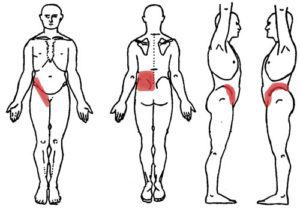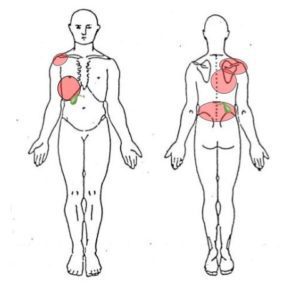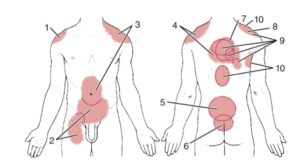Last week I talked about how trigger points in our muscles can cause pain in other areas of the body and how this can trick us. However, muscle trigger points are not the only structures in the body that are known to cause referred pain.
Our internal organs can do the same thing. The most classic example of this is the heart. We all know that chest pain and left arm pain are signs of a heart attack. When the heart is irritated or under stress, it refers pain down the arm. This is a great example of why it's so important to see a doctor who understands referred pain.
Imagine going to the hospital with chest and left arm pain, and the doctor starts treating your left arm. If that happened to you, you're probably not going to have a very good outcome! Even though the pain is in the left arm, the only way to get the pain to go away is to treat the heart which is the source of the pain.
In this blog, I'm going to go over the three most common internal-organ referred pains that I see in patients at my clinic.
The number one most common internal-organ referred pain that I see is for kidneys. This pain referral pattern is most often seen during the formation of a kidney stone, but other problems with the kidneys can cause the same thing.

As you can see in the picture above, the kidney can cause pain in the lower back, in the outer hips, and in the front of the hips. The most common presentation is in the low back and specifically the sides of the low back. This is called flank pain.
If you are experiencing pain in these areas, there are a couple of ways to distinguish whether this is just normal back pain or if it might be coming from your kidneys. In regular low back pain, the source of the pain is usually in the muscles, ligaments, and joints of the spine.
Because of the tissues that are irritated in normal low back pain, the pain will normally fluctuate throughout the day, depending on the position of your body and your activities. So the pain might be better at certain times of the days, but get worse when you do certain activities because those tissues are being stressed.
When the pain is coming as referred pain from the kidneys, the pain is usually constant and doesn't change, no matter what you do. If you're having pain like this that is constant, your best bet is to see your primary care doctor instead of a chiropractor or physical therapist.
The second most common internal-organ pain referral that I see in my clinic is the gall bladder. This one can confuse a lot of people. The gall bladder refers pain to lots of different areas of the body and many times in the beginning stages, there's not a lot of hints that the gall bladder is actually having problems.

As you can see in the picture above, the gall bladder sometimes can cause pain in the lower right rib cage which is right where the gall bladder is. However, a lot of times, it is known to refer pain to the top in the back of the right shoulder, and less commonly the low back.
There are a couple of clues that you can look for to see if your pain in these areas might be coming from your gall bladder. The best clue is if you notice this pain more after you eat, especially after you eat things that are high in fat content, as this is when the gall bladder goes to work to help digest the fat. The other clue you can look for is in your stool. When the gallbladder is not functioning properly, the food that we eat will not be properly digested and absorbed, and it will come out in your stool. If you notice after you go to the bathroom that your stool is either floating on the surface of the water or sticks to the side of the bowl ,this can indicate that your body is not properly digesting fat and that the gall bladder is in trouble. These clues would tip you off that you need to see your primary care physician instead of a physical therapist or a chiropractor.
The final most common internal-organ referred pain that I see in my clinic is from the stomach and intestines. Oftentimes, our GI system doesn't present with very obvious symptoms when it's under stress. Therefore, many times the first symptoms that a patient notices is the pain referral.

As you can see in the picture above, the stomach and intestines can refer pain to many different areas. The most common area that many people already understand is that if they feel pain in their abdomen, they most likely have something going on in their stomach or intestines.
What I see a lot in my clinic is pain in the low back being caused by the stomach or intestines. This can actually happen for multiple reasons. Sometimes the actual structures in the stomach or intestines can refer pain to the back, but another common thing that happens is when your stomach or intestines are irritated, they will actually send signals to the brain to decrease the activation in your core muscles so that the muscles do not press hard against the internal organs. This reduction in core muscle activity can also lead to low back pain.
*Note: If you are suffering from low back pain, one of the best tips that I give people to determine whether this might be coming from the stomach or intestines is simply to pay attention to the sensations in their abdomen. You should not feel your stomach and intestines during normal digestion.
Sadly, in America, many of our diets are very poor and we eat lots of inflammatory foods. So it might be very common for you to feel a burning or irritation after you eat - but this is not normal. If you are experiencing low back pain, and you commonly notice that after you eat you feel like a burning sensation or a discomfort in your belly this is a big sign that your low back pain may be coming from the stomach or intestines. Your first stop should be your primary care physician.
Unlike some of the other organs mentioned above, referred pain in your stomach and intestines may require a trip to your chiropractor or physical therapist after you've seen your primary care doctor.
If your pain was coming from the inactivity in the core muscles that I mentioned earlier, you may require some core activation exercises to help return your body to normal and decrease your low back pain.
So there you have it. Our body can be very tricky! And understanding referred pain is the best way to shorten the amount of time it takes you to get better. Like I was saying above, if you're having chest pain and left arm pain and your doctor wastes time treating your left arm first, it's going to take you longer to get better. So make sure you see a doctor who is knowledgeable on referred pain.
If you're in the Tulsa area and are experiencing pain that you think might be referred pain, give us a call at 918-300-4084. Dr. John Keefe can do a thorough exam and let you know if his care would be right for you or if you should go see your primary care doctor.
